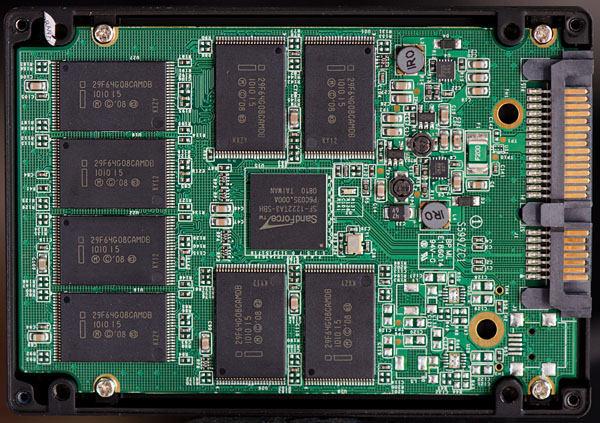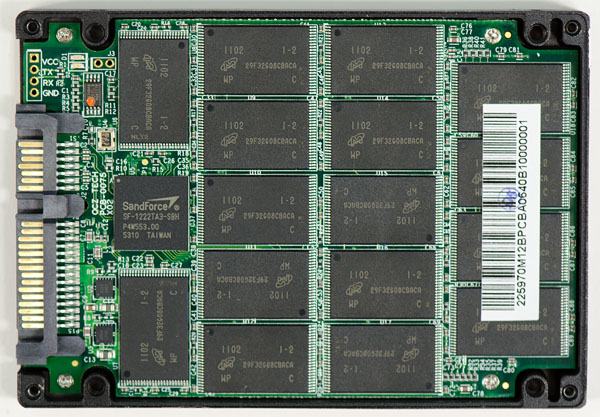The OCZ Vertex 3 Review (120GB)
by Anand Lal Shimpi on April 6, 2011 6:32 PM ESTThe Real Issue
While I was covering MWC a real issue with OCZ's SSDs erupted back home: OCZ aggressively moved to high density 25nm IMFT NAND and as a result was shipping product under the Vertex 2 name that was significantly slower than it used to be. Storage Review did a great job jumping on the issue right away.
Let's look at what caused the issue first.
When IMFT announced the move to 25nm it mentioned a doubling in NAND capacity per die. At 25nm you could now fit 64Gbit of MLC NAND (8GB) on a single die, twice what you could get at 34nm. With twice the density in the same die area, costs could come down considerably.

An IMFT 25nm 64Gbit (8GB) MLC NAND die
Remember NAND manufacturing is no different than microprocessor manufacturing. Cost savings aren't realized on day one because yields are usually higher on the older process. Newer wafers are usually more expensive as well. So although you get ~2x density improvement going to 25nm, your yields are lower and wafers are more expensive than they were at 34nm. Even Intel was only able to get a maximum of $110 decrease in price when going from the X25-M G2 to the SSD 320.
OCZ was eager to shift to 25nm. Last year SandForce was the first company to demonstrate 25nm Intel NAND on an SSD at IDF, clearly the controller support was there. As soon as it had the opportunity to, OCZ began migrating the Vertex 2 to 25nm NAND.
SSDs are a lot like GPUs, they are very wide, parallel beasts. While a GPU has a huge array of parallel cores, SSDs are made up of arrays of NAND die working in parallel. Most controllers have 8 channels they can use to talk to NAND devices in parallel, but each channel can often have multiple NAND die active at once.

A Corsair Force F120 using 34nm IMFT NAND
Double the NAND density per die and you can guess what happened next - performance went down considerably at certain capacity points. The most impacted were the smaller capacity drives, e.g. the 60GB Vertex 2. Remember the SF-1200 is only an 8-channel controller so it only needs eight devices to technically be fully populated. However within a single NAND device, multiple die can be active concurrently and in the first 25nm 60GB Vertex 2s there was only one die per NAND package. The end result was significantly reduced performance in some cases, however OCZ failed to change the speed ratings on the drives themselves.
The matter is complicated by the way SandForce's NAND redundancy works. The SF-1000 series controllers have a feature called RAISE that allows your drive to keep working even if a single NAND die fails. The controller accomplishes this redundancy by writing parity data across all NAND devices in the SSD. Should one die fail, the lost data is reconstructed from the remaining data + parity and mapped to a new location in NAND. As a result, total drive capacity is reduced by the size of a single NAND die. With twice the density per NAND die in these early 25nm drives, usable capacity was also reduced when OCZ made the switch with Vertex 2.
The end result was that you could buy a 60GB Vertex 2 with lower performance and less available space without even knowing it.

A 120GB Vertex 2 using 25nm Micron NAND
After a dose of public retribution OCZ agreed to allow end users to swap 25nm Vertex 2s for 34nm drives, they would simply have to pay the difference in cost. OCZ realized that was yet another mistake and eventually allowed the swap for free (thankfully no one was ever charged), which is what should have been done from the start. OCZ went one step further and stopped using 64Gbit NAND in the 60GB Vertex 2, although drives still exist in the channel since no recall was issued.
OCZ ultimately took care of those users who were left with a drive that was slower (and had less capacity) than they thought they were getting. But the problem was far from over.










153 Comments
View All Comments
Super - Friday, April 8, 2011 - link
...perhaps the Nobel Peace Prize. ?? i've seen someone win it for a whole lot less *cough ObamaA5 - Wednesday, April 6, 2011 - link
Agreed - glad they listen to Anand.The real question is why they didn't do anything until Anand bitched to the CEO directly. It's not like they weren't aware of the issue - the Storage Review article came out several months ago...
darckhart - Wednesday, April 6, 2011 - link
It just goes to show that companies are not customer focused. Unless they get shoved hard enough, or see that the bottom line will be affected greatly, they just hope you'll give up after being mired in the revolving email chain or sent through 5 level deep phone support.Thanks Anand for reminding companies that some of us are still capable of making informed decisions and aren't afraid to express our dissatisfaction with our dollars.
789427 - Thursday, April 7, 2011 - link
It's not about being customer focussed or not. Quite frankly, what percentage of upgraders will go into this level of detail?Furthermore, 25nm sounds better than 35nm to most people and that's salesmen included.
After all that, it's a victory for transparency for a tiny few.
In terms of marketing, there's little you can do except re-brand the entire product range.
e.g. Silver and Silver Pro for the lower capacities, Gold and Gold Pro for the higher capacities and explain on the box that fewer chips means generally lower performance
The problem here is that this is the cutting edge of technology and that in 12 months time, it will be surpassed. Then how do you re-vamp the line?
Graphics cards have this problem too and the model numbers are baffling for 99% of first-time buyers.
What I would advocate is a sticker valid for 3 months on the product that lets you know which product in terms of performance you are buying and a URL you can visit to check for an update.
e.g.
Your product: xyz 300-35
is better than xyz 300-24
but is worse than 300-ii
Check Real performance figures here: URL
Then it would be nice for salesmen to allow customers to verify this.
cb
cactusdog - Wednesday, April 6, 2011 - link
Yep, at least OCZ have made a commitment not to use slow hynix nand and are being more transparent with real world performance but its all too little too late.Branding drives with the 25 or 34nm prefix is redundant now that all(or most) nand being produced is 25nm. Ocz made no real attempt to fix the problem when they needed to, and continued to sell the drives even after the consumer backlash.
I disagree with Anand that other manufacturers of sandforce controller drives hide the specs as OCZ did. Corsair rebranded their 25nm drives from the start. Other non sandforce drives from Intel also rebranded their 25nm drives.
Its true that many companies use different components and use the same branding but rarely does the performance vary as much as 30%. 30% is a huge and not acceptable for high end expensive parts..
Its a pity Anand didnt really have anything to add on the Spectek issue that hasnt already been said. I find it hard to believe a company like Micron would sell very expensive nand cheaper to Spectek unless there is some problem with it.
Saying Spectek nand must be OK because it is still rated at 3000 cycles doesnt sound very thorough or tell us the whole story. The cycle rating could have very different testing standards between Micron and Spectek.
I would have thought it would be easy for someone like Anand to ask Micron or Spectek if the Spectek nand is tier 1 nand or not. I wouldnt trust OCZ response given their track record.
Overall though thanks Anand for sticking up for the consumers.
Powerlurker - Wednesday, April 6, 2011 - link
According to their corporate website "SpecTek began at Micron in 1988 as a component-recovery group." which would lead me to believe that they're Micron's low-end brand for disposing of lower performing dies.Xneb - Thursday, April 7, 2011 - link
That is correct. testing is the same though so end users should not be able to tell the difference between spectek and imft nand in these drives.sleepeeg3 - Thursday, April 7, 2011 - link
You can't fault him for reporting honestly. There is no concrete data that shows Spectek NAND is inferior to Micron.Alkapwn - Wednesday, April 6, 2011 - link
Ditto! Keep up the great work! We all appreciate it greatly!Mr Perfect - Thursday, April 7, 2011 - link
Yes, thank you for addressing the Vertex 2 issue.The sad part is that if OCZ had used their new, transparent labeling scheme from day one, they would have been praised for their transparency and all of the other companies would have been expected to rise to their standard. Instead, they waited through months of consumer and press outcry, meaning this fair and honest SKU system is merely re-earning lost trust.